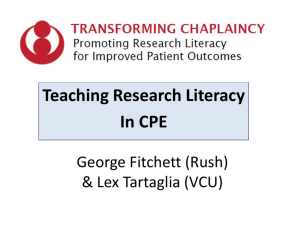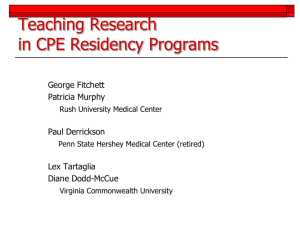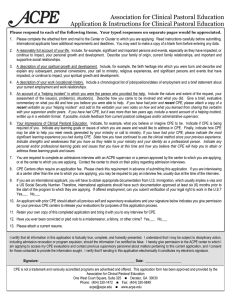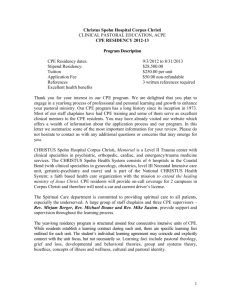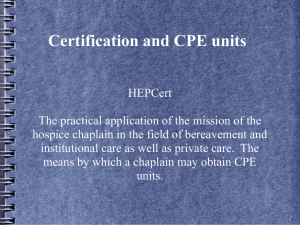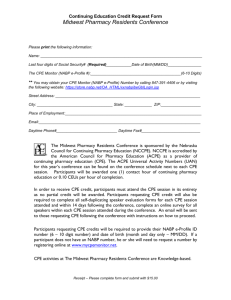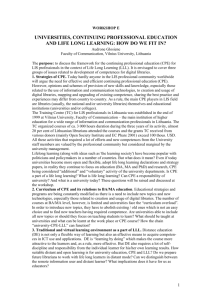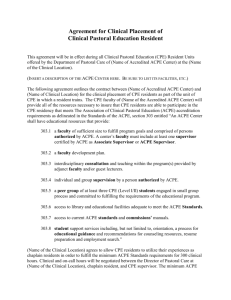Teaching Research in CPE Residency Programs
advertisement
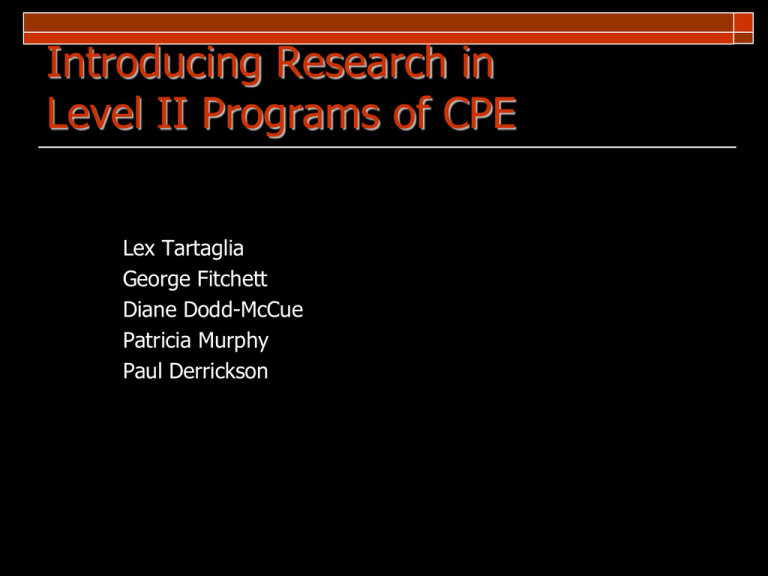
Introducing Research in Level II Programs of CPE Lex Tartaglia George Fitchett Diane Dodd-McCue Patricia Murphy Paul Derrickson Workshop Objectives At the completion of this workshop participants will: be aware of the current state of teaching about research in ACPE residency programs; be familiar with examples of syllabi that will help CPE residents develop research literacy and explore research involvement; be familiar with specific methodologies to incorporate research literacy basics in a CPE residency curriculum. Making the Case Standard 12: Research The chaplain practices evidencebased care including ongoing evaluation of new practices and when appropriate, contributes to or conducts research. (http://www.professionalchaplains.org ) 3 Making the Case A research-literate chaplain has the ability to read, understand, and summarize a research study and to explain its relevance for his/her spiritual care. Mowat H (2008). The potential for efficacy of healthcare chaplaincy and spiritual care provision in the NHS (UK): A scoping review of recent research. www.nhs-chaplaincy-collaboratives.com/efficacy0801.pdf 4 Making the Case Basic research literacy includes: Attitudes about role of research in chaplaincy •Recognize importance of research for chaplains •Motivate to engage in research-related activities, including journal clubs, workshops, grand rounds Behavior about research •Reduce fear and avoidance of research-related activities •Encourage curiosity and development of research questions •Integrate research findings into professional practice Knowledge •Identify research databases and search existing literature •Understand basic concepts needed to read and critically evaluate simple qualitative and quantitative research articles Research Question Study #1 To what extent are ACPE accredited residency programs educating students for research literacy and competence in support of Standard 12? Results by the Numbers Yes Some CPE Centers 3 (14%) 5 (24%) CPE Systems 0 (0%) 2 (40%) All Programs 3 7 (27%) (12%) No 13 (62%) 3 (60%) 16 (62%) All results were independently coded by 3 members of research team (88% initial agreement) Differences were resolved among discussion of entire team Issues Identified One myth expressed by multiple persons was that RESEARCH EDUCATION only means students conduct a large project or randomized study. A number of centers made opportunities for learning research basics available, but application was either inconsistent or optional. Some supervisors expressed that research education was beyond the program goals of a “first year residency”. A few supervisors thought that more research was needed to demonstrate efficacy of CPE for training of healthcare chaplains. Study #2 Model Practices IRB approval at each institution Non experimental descriptive design using semistructured interviews and a purposeful sample Selected from centers identified in study 1, identified by ACPE Research Committee Chair, identified through publications Inclusion criteria: meet learning objective of research literacy; substantive teaching (time, content, activities); required of all residents; one full year completed Contacted 21 centers, interviewed 15, and 11 met inclusion criteria Similarities Aim: research literacy Current practice developed over time (often longer than expected) Presence of a research champion Associated with academic medical center or system with organizational culture of research/evidence based practice Institutional resources (people) Methods employed: content based didactics; journal articles; application to verbatim material; journal clubs; literature reviews; applied research (question, data collection, etc.) Differences Time commitment Complexity Supervisor Involvement Challenges Availability of personnel resources to support program Time management Competing priorities Supervisor involvement Five ways to Incorporate Research Didactic Series Journal Clubs Research Article Critiques Developing Literature Reviews Clinical Pathways Didactic Content Examples Research Types (Qualitative vs. Quantitative/Descriptive vs. Interventional) Nomenclature Developing a Research Question Library Database Searches and Literature Reviews Use of Tools, Measures, Surveys Research Ethics, IRBs (Training Modules) Dissemination and Writing for Research Didactic Content Scorecard Advantages Easy to organize Easy to incorporate Limited investment Time controlled Disadvantages Resource dependent Passive Journal Clubs Focus on selected research or researchrelated article Emphasis on relevance to chaplaincy Emphasis on process of conducting study Journal Club Scoreboard Advantages Easy to organize Limited resource demands Article selection tailored to interests of audience Group interaction Responsibility need not fall on one individual Disadvantages Leadership may vary Assumes everyone prepared to participate Level of participation may not reflect informed participation Research Article Critiques Focus on selected research article Emphasis on research methodology Reliance on established or agreed upon critique format Critique Scoreboard Advantages Systematic review using established, relevant criteria Criteria compliment those used in refereed article and grant proposal reviews Group interaction Disadvantages Requires baseline familiarity with research terminology Assumes individual providing critique is informed, knowledgeable Greater time commitment than journal club Developing Literature Reviews Focus on topic of interest and relevance Builds on effective reference research skills Complements critical thinking skills Allows creativity in developing themes across research thread Literature Review Scorecard Advantages Reinforces effective research skills Provides opportunity to gain in depth understanding of status of specific topic Provides experience helpful in writing articles and grant proposal Disadvantages Assumes access to reference resources Usually solo project Demands synthesis and thematic identification Implies strong writing skills More time consuming than journal club or critique Spiritual Pathway Project Focuses on evidence based practice Simulates participation in quality improvement initiatives Teaches basic research skills such as data collection Provides opportunity for public presentation and dissemination of new information Enhances inter-professional dialogue Spiritual Pathway Scorecard Advantages Student choice focused Promotes evidence based thinking Encourages accountability to peers and colleagues Requires development of time management skills Improves writing for publication skills Disadvantages Time intensive Supervisor Dependent Increases academic demands- amount and speed of curriculum Sophistication level may need IRB approval Quick Comparisons: (High-low level of commitment) The Potential for……. (High-low level of result) Resources ACPE Research Network Page APC Webinars Journal of Healthcare Chaplaincy Teaching Research in CPE: A Survey of Model Practices, JPCC, Spring 2013. A Primer for Pastoral Care, VandeCreek, JPC Publications, 1988. Thank you for your interest Questions? Comments? Please contact us
